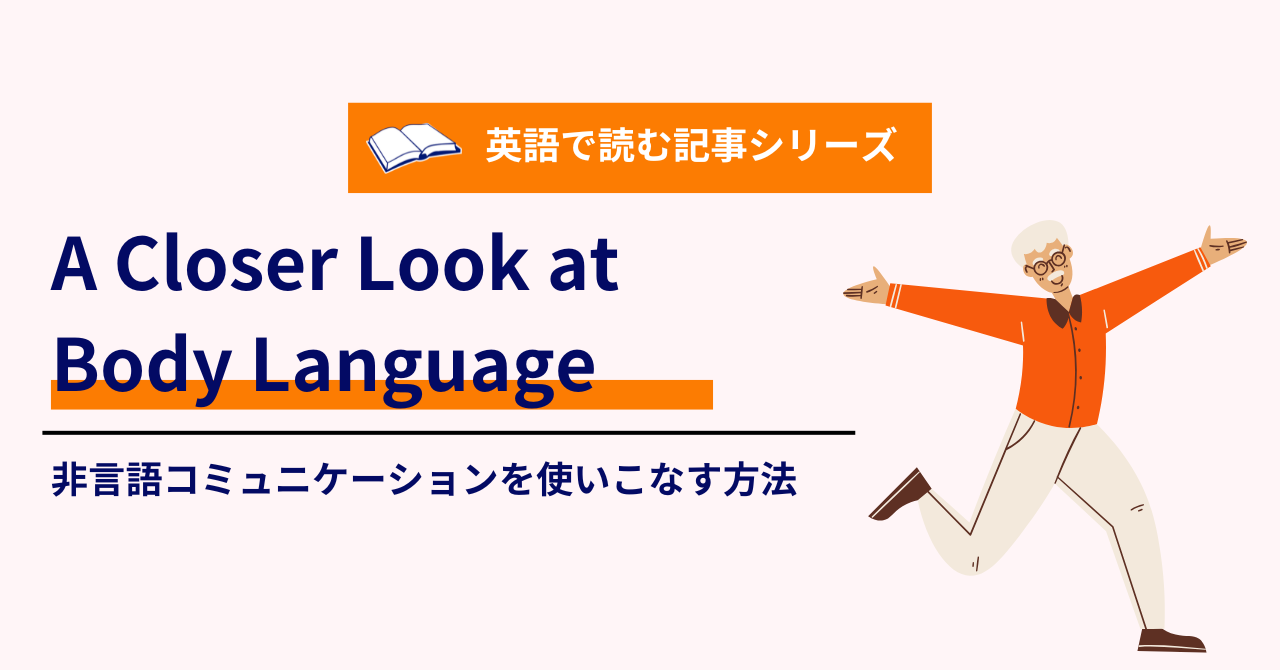
英語が話せるようになればなるほど、「自分の英語はネイティブスピーカーにどう聞こえているんだろう」、「ネイティブスピーカーの頭の中はどうなっているんだろう」と感じることが増えますよね。
そこで、【ネイティブ講師直伝】のコーナーでは、One Month Programのネイティブ英語講師陣が、英語学習に役立つヒントを「英語で」皆様にお伝えしていきます!
英語学習をネイティブスピーカーの視点からとらえ、英語で英語を学ぶ習慣をつけていきましょう!
リーディングの練習もできるようになっていますので、読むのにかかった時間、正答数はしっかり記録しておいてくださいね。
今回のテーマは「非言語コミュニケーション」です。
ジャスチャーやアイコンタクトなど、言葉だけのみならず、非言語コミュニケーションは相手との意思疎通をスムーズにしたり、逆に使い方を誤るとミスコミュニケーションの要因になったりします。
英語のネイティブスピーカーと会話をする際には、どんな非言語コミュニケーションに気を付けるべきでしょうか。本記事で学びましょう!
リーディング時間目安:3分 / 450語 ※WPM=150
1. 下記の英文を読みましょう。3分以内に読み終えられたら上級者です。
2. 読み終えたら、文章下部の問題に解答しましょう。
※テストの練習ではないため、問題文は記事をすべて読み終えてからにしましょう。
(答えを探しながら読むのではなく、内容を理解しながら読むことを心がけましょう。)
3. 記事末尾に解答がありますので、答え合わせをして終了です。
A Closer Look at Body Language
by Jonathan Muranaka
Nonverbal cues can convey just as much as words do. Whether you are using them to accent a point, or signaling to someone else that you are paying attention, they are an indispensable part of your communication toolset.
Learning and practicing them will help you appear more confident, engaged, and trustworthy during conversations, so let’s go over some of the most commonly used nonverbal cues.
Eye Contact: A Sign of Confidence and Engagement
This is essential in English-speaking cultures. It communicates attentiveness, confidence, and sincerity. Maintaining direct eye contact while listening shows that you are focused and interested in the conversation.
However, AVOID holding eye contact for too long without breaking. Prolonged eye contact can make the other person feel uneasy or make you appear confrontational.
Hand Gestures: Complementing Your Speech
These can emphasize your points and make your speech more dynamic. Using open hand gestures, like spreading your palms outward while explaining something, signals openness and honesty.
AVOID using excessive hand movements because they can be distracting or perceived as nervous energy.
Posture: Projecting Authority and Confidence
The way you carry yourself speaks volumes. Your posture can communicate confidence, authority, preparedness, as well as your interest in the topic being discussed. Whether sitting or standing, try to keep your posture upright and relax your shoulders and arms. You can lean in a bit when someone else is talking to show attentiveness.
AVOID slouching or crossing your arms. The former can make you seem apathetic, while the latter can make you look closed off or upset.
Facial Expressions: Conveying Emotions
Be mindful of your facial expressions, especially during presentations or discussions. A slight smile can make you seem approachable and positive. Conversely, a frown or furrowed brow can express concern or disagreement.
AVOID using excessive or over the top facial expressions, as they can be distracting or seen as unprofessional.
Personal Space: Respecting Boundaries
Maintaining appropriate personal space is crucial. A distance of about one to two arms’ lengths is typically appropriate. If you are close with the other person, this distance can vary, but observe how others position themselves in meetings or formal gatherings and adapt accordingly.
AVOID standing too close or far away from someone. This can make you seem intrusive or overly assertive, while being too far away can signal disinterest.
Nodding: Active Listening
Nodding is a simple yet effective way to show that you are following the conversation. Use subtle nods when someone is explaining a point. A slight nod combined with appropriate facial expressions can demonstrate genuine interest and understanding.
AVOID excessive nodding as this can come off as insincere.
Question 1
What is the primary function of maintaining eye contact in English-speaking cultures, as mentioned in the text?
a) To make the other person feel uneasy.
b) To show attentiveness, confidence, and sincerity.
c) To emphasize openness and honesty.
d) To avoid confrontation.
Question 2
Which posture-related behavior should you avoid, according to the text?
a) Leaning slightly forward when someone else is talking.
b) Keeping your shoulders relaxed and arms open.
c) Slouching or crossing your arms.
d) Sitting upright with a confident posture.
Question 3
Why is nodding considered an effective nonverbal cue during conversations?
a) It demonstrates authority and preparedness.
b) It shows you are listening actively and helps express genuine interest.
c) It keeps others from speaking too much.
d) It highlights your personal boundaries.
いかがでしたか?
英文を読み始めてから~答え合わせまで、計10分程度で終えられると理想的です。
間違えた問題があった方は、もう一度読み直して復習してみてくださいね。
それでは次回の【ネイティブ講師直伝】のコーナーもお楽しみに!
【Questions 解答】Q1. b Q2. c Q3. b
Writer
One Month Program
グローバルで活躍できる人材のための英語情報を発信します。
ビジネスに特化した1か月の超短期集中英語プログラム
https://www.ten-nine.co.jp/onemonthprogram/
運営会社:【通訳・翻訳・英語教育】テンナイン・コミュニケーション
https://www.ten-nine.co.jp/






